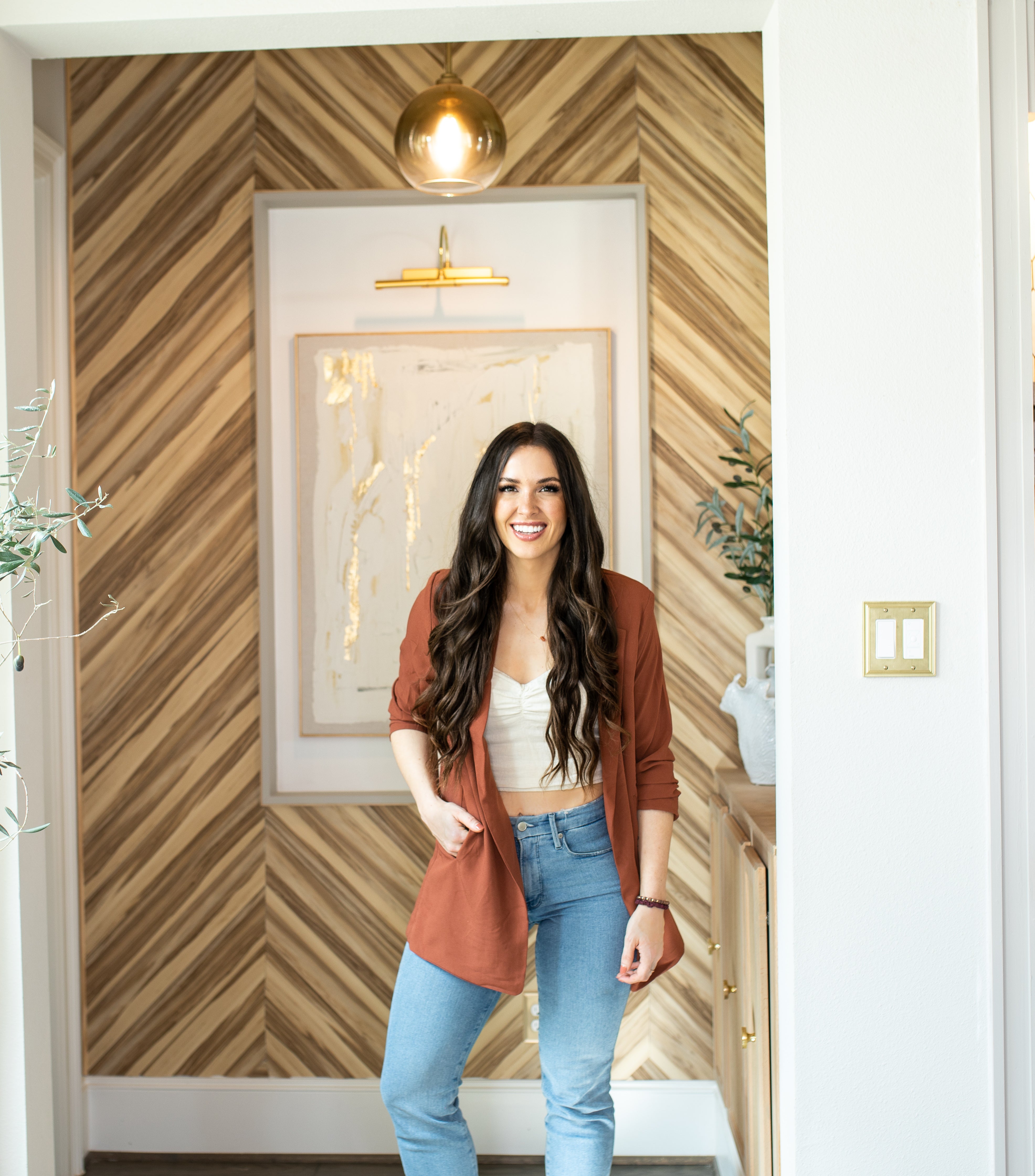In Ask an Influencer, Business of Home explores the creator economy. This week, we spoke with Cara Newhart, the Houston-based designer known on Instagram by her handle @neverskipbrunch.
Despite dabbling in other online niches first, Cara Newhart’s content only really took off when she started posting about home and design—which, when you learn about her upbringing, makes perfect sense. Her dad was a home builder and contractor in Dallas, and her mom was “basically Pinterest as a person,” which spelled the perfect recipe for Newhart to spend her childhood years drawing up floor plans for her bedroom and sneaking paint out of the garage when her space needed a refresh.
But when it came to her career, Newhart had other plans. Ambitious and eager to take on the corporate world, she entered the oil and gas finance industry after earning her degree in energy management (with an art minor, of course). Along the way, she began experimenting with social media, first launching a fashion blog before transitioning to making content about the act of blogging itself—a venture that garnered a slow but steady following. Then, in 2019, she bought her first house after relocating to Denver. “It was a lot of money for a lot of nothing: a big, blank, boring builder-grade house,” says Newhart. “I had very expensive taste and very wild ideas and no money to make them happen. So I was like, ‘I’m just going to teach myself.’”
Newhart began documenting the process on social media, and finally, her followers started talking back—asking for advice, updates and help with their own home projects. When the pandemic hit, it supercharged her early success, netting her a loyal following that today numbers 209,000 Instagram followers who tune into both her social posts and her podcast, Make Space.
Ahead, Newhart shares how she embraces new trends without abandoning the core of her business, why online design resources are dissolving traditional design industry roles, and how the evolution of social media has pushed personal connection-making off of the platform.
When did you start approaching social media with a strategy?
For me, it was very gradual. But once brands started approaching me with collaboration ideas, that was when I was like, “Wait a second, this is a business.” The strategy has always been a very strong balance between analytics and connection. I think you can have incredibly huge viral videos that are missing the connection piece, and vice versa—a really good, deep connection but not huge numbers. So my strategy for social media has always been to balance both—to really use analytics to inform what’s working, but also to make sure that it’s still a very organic place to try new things and get feedback and just talk to people and hang out and let it be fun.
It’s a blend of logic and experimentation, especially for branded content. There, I have more tried-and-true content, and I know how to make a good solid Reel video that I know will work for my audience and the brand. But then I’m also trying out trends and trending sounds and different platforms like TikTok—before it blew up, I was there just playing. Because social media evolves so quickly, you have to be clear on what works in terms of analytics, but you can’t get too stuck, and the only way not to get stuck is just to fling stuff out there and see how it does. It’s going back and forth, focusing on one and then the other, and then they inform each other—like a big feedback loop.

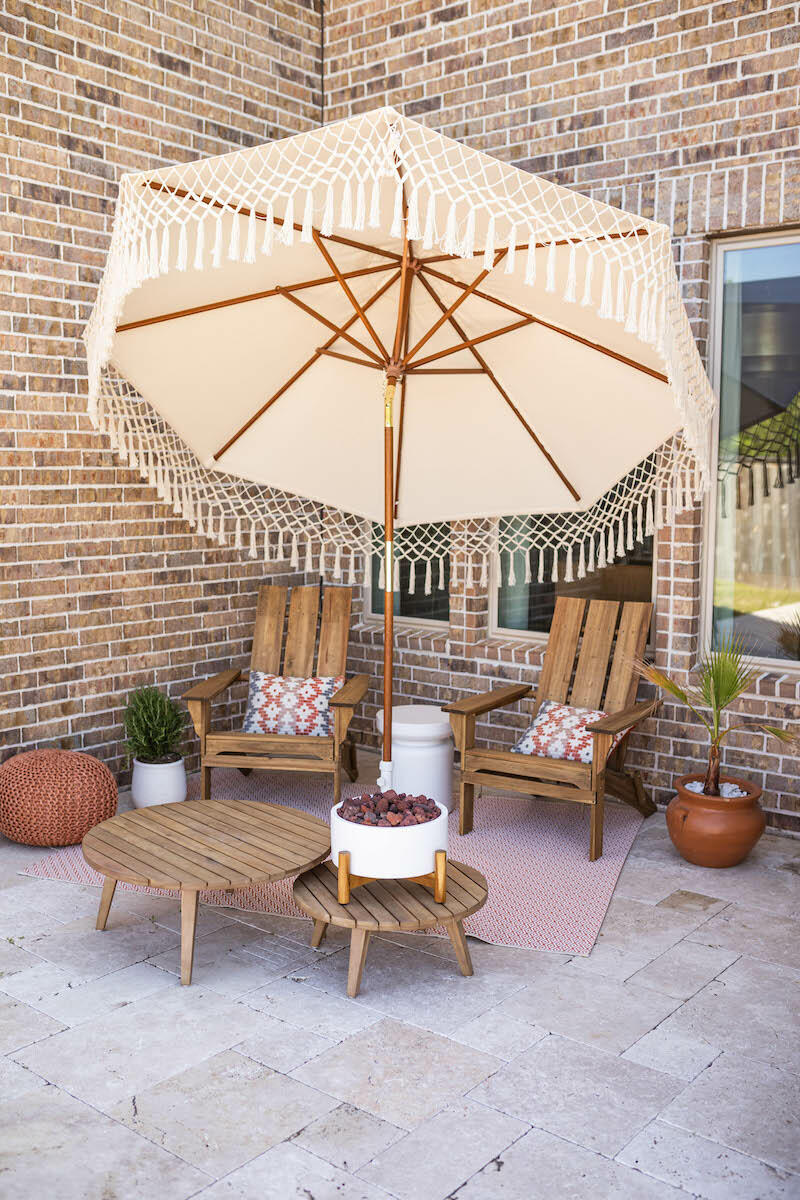
How does that strategy inform what you’re posting today, and how has that evolved over the years?
I’ve totally done a 180. When I first started, we were on Instagram just posting photos—it was back when Stories first came out, and not a lot of people wanted to be there. I think people were scared of video, and they really liked the ability to edit on a photo—you can use a filter and take your time with an image—but Stories just felt very raw, very in the moment. A lot of people weren’t ready—especially in the home space—to jump on that, because home stuff then was [mostly about] sharing inspiration and spaces, so being a talking head in Stories was really weird for a lot of people. But I’ve pushed myself to whatever everyone’s afraid of—sprint in that direction, because that’s where the best stuff is. Then you get to mess up early and be good whenever everyone finally jumps on the bandwagon.
So I started to do a bunch of Stories, and I would showcase a step-by-step of a project that I was doing, then post a photo reveal and really build up to the big reveal, which now, I don’t think works as well. What we were doing then in Stories is what people are now doing in Reels—showing the raw, the everyday. It’s definitely still curated and polished spaces, but more of the behind-the-scenes of how you got there. Today, social media is an overwhelming fire hose of inspiration, and so people are less interested in a beautiful space and more interested in the process, or in something they’ve never seen before, or the story behind it. Story, being raw video—that’s what we’ve shifted to, as opposed to photos and aspirational spaces.
How did you approach the transition toward video?
I was ready for something new. I have a background in photography, so I loved shooting beautiful photos, but something about showing my creative process has always been a really important part to me—that we’re not just showing a before and after, because to me, that’s just uninteresting. The process of how we got there is important, especially as someone that’s trying to empower everyday people to do things in their house. If it’s just a before and after, you could get a designer and you don’t need to understand the process. But if you’re doing it yourself, you need to know how to do it. With the rawness of video, I really liked the ability to showcase that in a new way. Every time there was a new feature, I jumped on and tried it out. I got to play around on TikTok where it felt like nobody knew me because it was such a new platform, so I really honed my short-form video editing skills over there, with no strings attached. By the time Reels rolled out, I was confident in my skills. I also had a ton of videos that I could just repurpose, so that was kind of the perfect storm—and then YouTube launched Shorts, and Pinterest launched Idea Pins, and suddenly you could make one piece of content and put it everywhere, which never was a thing before, because every platform was so individualized and tailored.
What does the process of producing content look like for you?
I own a $5,000 camera, but I actually always use my phone and this app called InShot, which I think I pay $14 a year for. I find that really encouraging because it means the value of content is in the story and the substance of what you’re sharing versus the gear. People like that rawness nowadays—it used to be that the best photo won on Instagram, and professional photographers really excelled. Now, I think personality and story is the driver. The quality has to be good enough so it’s not annoying to watch, like the audio isn’t horrible or super grainy, but it just has to be good enough. I still drag out the camera every once in a while to document professional design projects for my portfolio, but day to day I’m just getting by with the basics.
Do you have a content schedule?
There are definitely set pieces—any kind of brand content usually has a determined timeline. But as far as stuff that I’m sharing organically, I like to leave it really open. I have a running list of ideas I want to create, or things I’ve already shot, but in terms of what I’m posting every day I’m not a planner by any means. I do have an assistant now, and we schedule stuff on my nonprimary platforms—so she does Facebook, Pinterest, sometimes YouTube—but I still post everything with my own two hands on TikTok and Instagram.
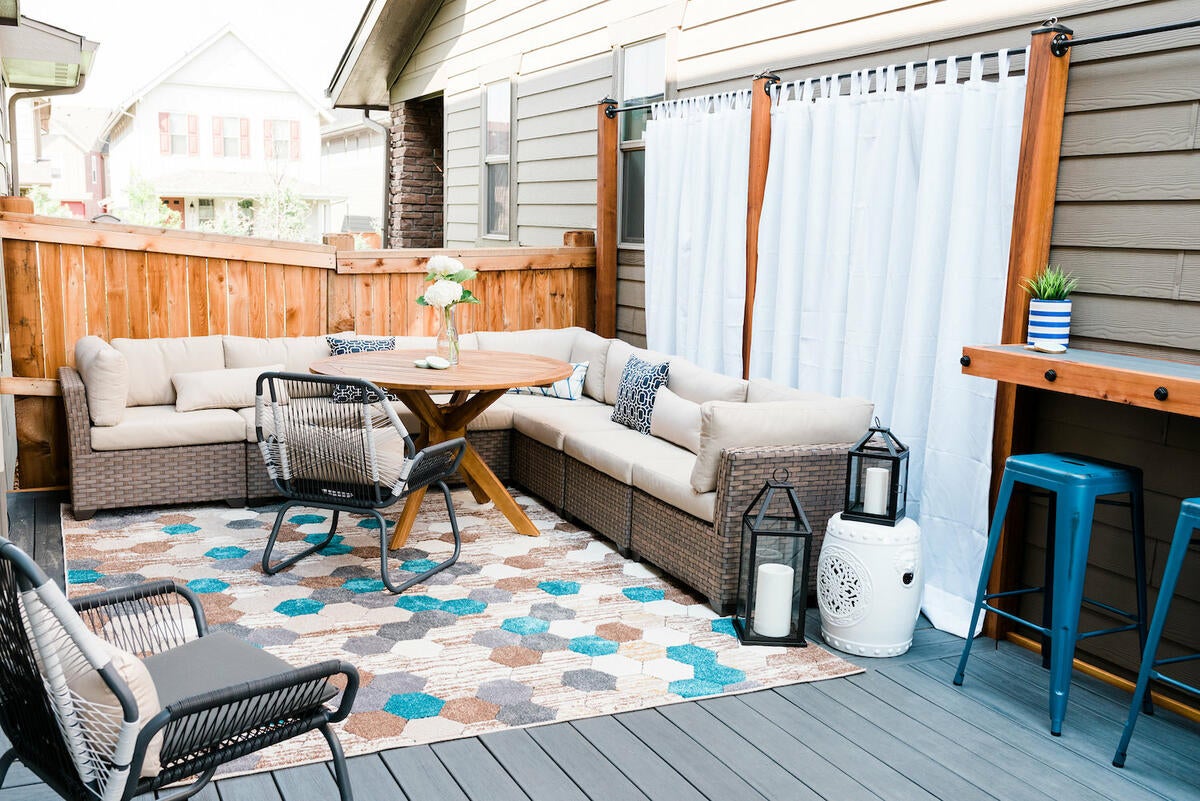
How do you work with brands or otherwise utilize your social media from a business perspective?
The bulk of my revenue is definitely brand deals—either social content, project-based or tutorial-based—or from the podcast, through ads from brand partners there. I also do design consults, just because I love them so much and I think there are not a lot of solutions for people out there that want to be heavy in the DIY space but still want a really elevated look. It’s not full-service design, but just walking around your house, I’ll create a list of products, I’ll help you source things as needed. I also do DIY project coaching, so if people have started DIY projects, and they’re stuck and need some help, or they just don’t even know where to start, I hop on a call and help people plan. I love helping people one-on-one, which is really special because my audience has grown to a point where I don’t really get to reply to every comment—I’d be on my phone for years—so that’s a cool way to get to go deep and really connect and put my ear to the ground and see what people are up to in their homes.
When did you initially launch your podcast?
Four and a half years ago, right around the time I switched to home decor. It’s actually my second podcast—before this, I had a business podcast about content creation and blogging. The current one, Make Space, started as a passion project, because the original podcast was so structured and business-y and technical. This was just like, let’s explore all the different ways we make our houses, whether that’s designers or everyday people. It really is about trying to inspire everyday people to create spaces they love, whether that’s hands-on with power tools, or just the intentionality and thought process in how to set up your home so that it supports your everyday life. I think it’s so interesting because we make goals for our fitness, goals for our budget, but we don’t really make goals for our house unless you’re in the middle of a renovation. If you can be intentional about how you’re setting up your house, you can literally change your life—that’s why it’s called Make Space. So much of the show is actually the mindset piece. You may think of your house as 80 or 90 percent physical and based on how it looks, but it really is more 50-50 in terms of how it looks versus how it feels and functions.
How do you approach fielding comments and DMs?
I try to have a healthy boundary around doing my best to honor the fact that they took time to leave a comment and also knowing that it’s physically impossible for me personally to reply to everybody. I have dedicated times where I just sit and catch up on comments, or I usually do engagement time right after I post something, where I’ll comment back and forth. It just depends on what the comment is as far as how I prioritize. A lot of time it’s people asking for help, but that should really be a consult call, so if that’s a better fit, I push it in that direction.
Do you use social media for personal reasons anymore?
I would rather just text someone a photo or updates, or have people reach out to me to check in versus broadcasting my life, where it’s like, “Here’s what I’m up to!” Because I turned social media into a job, it’s taken the magic out of using it personally, but I also think social media has evolved—when it first came out, it was very much your close circle in linear time, and it’s not like that anymore. The algorithms have changed, the way people use the app has changed, and a lot of the actual connection can happen offline, whether it’s in person or texts or phone calls.
How do you approach platform updates and algorithm shifts?
I’m very entertained by Instagram’s new features, because honestly, their strategy is just when [another platform] is doing something good—they do that. Instagram Stories came from Snapchat; IGTV back in the day came from YouTube; Reels are from TikTok; the little statuses you can now post are from Twitter. It’s like they have no original ideas.
But if Instagram adds a new feature, I’m using it immediately, even just to explore it or to see what it’s about. Anytime a social platform adds a new feature, that’s what they’re pushing in the algorithms because they have to hit a critical mass of enough people using it that it becomes integrated and a staple. Even if I hate it, I will jump on it and try it out and use it as much as it makes sense for my audience. I definitely am not spending a lot of time on new features because I also know they can be taken away just as soon as they’re added, like the IGTV vertical video that they tried so hard to push. Nobody liked that, so now, it doesn’t exist anymore. So I think it’s a healthy balance—definitely try it, definitely get on it, but don’t make it your new strategy to just chase trends. You have to have a core business that can survive without trends. And then, whenever you’re iterating and evolving, you’re going to need to use the trends—and the sooner, the better, because you’ll be an early adopter and understand how it works.
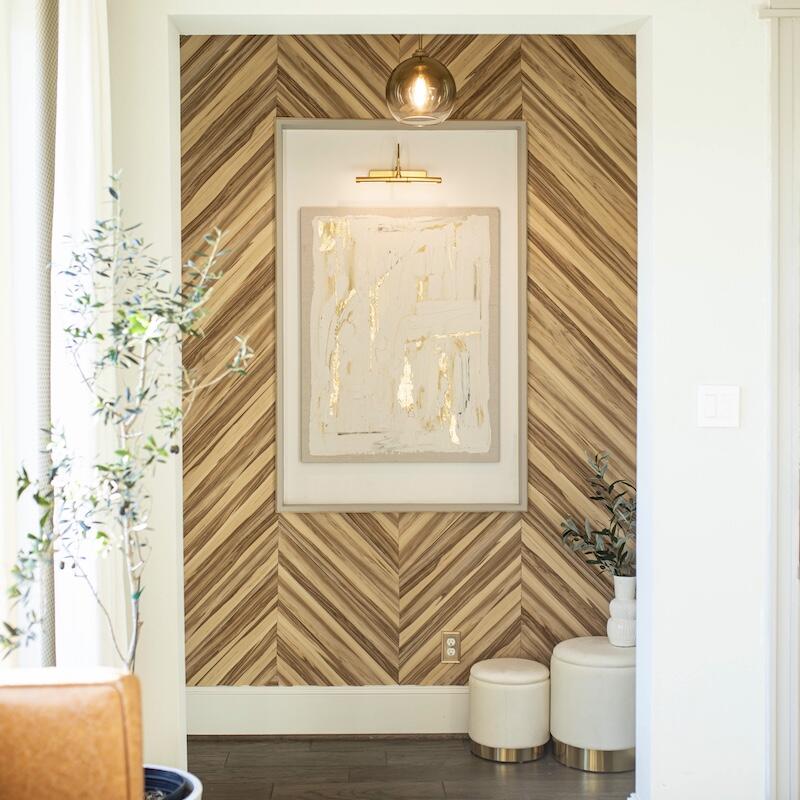
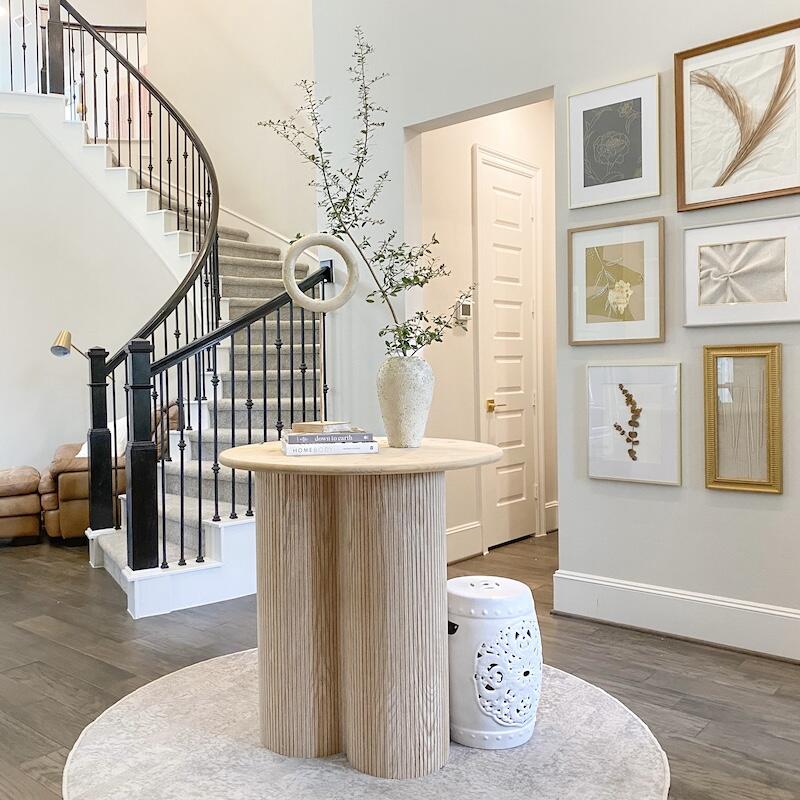
Did your life change when you started to build a following?
Not for me. I think it’s really funny; when I was just starting out and looking at people with like 100,000 followers—at this point, I have almost a million across the whole internet—I was really thinking, “Wow, their life must be so different than mine.” But it doesn’t change as much as you think it would. I have to grapple with milestones like, “When I hit 200K, or when I hit the next one, it’ll be so different and I will have made it.” But it’s like, no, you’ll just raise the bar—there can always be more.
My life is the same as a normal person, but I just choose to put it all over the internet for people to watch. Sometimes people recognize me, like in the checkout at Whole Foods or at Home Depot, people will come up to me and be like, “Oh, my God!” and fangirl, which I think is so sweet. I’m just so normal, and I’m also so excited that they got to see me being normal in real life, because I look exactly the same and I am the same and I’m just as weird. A lot of people think that a big following comes with a certain lifestyle, but it doesn’t.
Do you refer to yourself as a designer, an influencer, a content creator or something else?
I refer to myself as a designer because I do have an official design certificate program that I did, and I take on client work occasionally. I also go with the term “designer” because I think DIYer has the connotation that you’re just doing it all yourself, and you don’t have any formal training or honed practice in a formal field. But at this point, I’m renovating an entire house and working with experts, and I’m the GC on that project. I like to set myself apart as someone that’s working with experience because I think it’s important to differentiate yourself. All that to say: There’s no good title because it is a weird in-between space.
Design used to be such a specific job, and now it’s so integrated and cross-pollinated with so many different industries. I feel like I’m always toeing the line between interior designer doing client work and contractor doing construction, and there’s no good job title for that. I find it helpful to relax the boundaries we used to hold so tightly. How do we look at the industry, at the way we’ve always done things, and dissolve some of the gatekeeping that isn’t necessary? I think [that process] is leading a lot of people to be able to access good design and good strategy for their own house that was not available to them before. This is a beautiful part of designers being on social media—sharing knowledge that before you would have had to book a service with them to get. Sharing expertise in that tangible way is a really cool phenomenon to see happening in the industry.
What’s the biggest challenge for you right now on social media?
Letting it be simple. As things grow, and you go on to bigger projects and bigger collaborations with higher stakes, there’s a lot of pressure to make everything amazing or make every project crazy and over-the-top. For me, it’s about remembering that the whole reason I’m here is to inspire actual everyday people to do tangible things in their house. Staying connected with that mission is just letting things be simple—balancing big wild projects and really cool brand collaborations with everyday content that’s going to help people.
Homepage image: Cara Newhart | Courtesy of Cara Newhart
















